I'm helping set up an Airsoft arena in the UK and I plan to have RC-FPV cameras mounted on the weaponry and masks which the players use/wear (similar to wireless drone cameras). As it's an open space we'll be testing the 5.8 GHz bandwidth first using 40 channel transmitters/receivers.
A few people have suggested that using anything over 8 channels in this bandwidth concurrently would cause problems but what would those problems be?
For example:
Would the video become merged or blended with neighboring channels?
Would the receiver swap from transmitter to transmitter depending on the signal strength?
Would it just not work?
Or something else?
It just not working and signal merging would represent a problem for me but just channel hopping is no major issue.
These are the channels available in one of the systems we are considering.

In case it's relevant here are the available specs.
5.8G 600mW 40 Channel Wireless AV Transmitter:
Transmitter Frequency /Channel Amount: 5 bands / 8 channel each = 40 frequencies
Output Power:600mW
Frequency Control: Built-in frequency & phase lock loop
AV input: Analog AV signal input
ANT connector: SMA (needle inside)
Power Supply: DC 7-12 volts
Current Consumption: 220mA
Size: 54*32*10mm
Neat weight: 22g
Some additional specifications as a clarification to answer questions:
I'll be streaming low quality AV (320tvl at 24fps and 22 kHz audio) which should come in at under 18mhz bandwidth per device. The modulation is most likely to be Airwave on one side and Boscam on the other.
To clarify, this is not a duplicate question to How to avoid interference in wireless communication. While everyone would like to avoid interference my question relates to what would happen when interference is encountered.